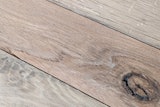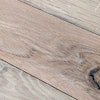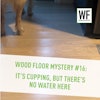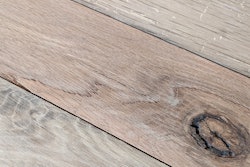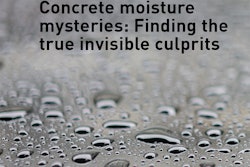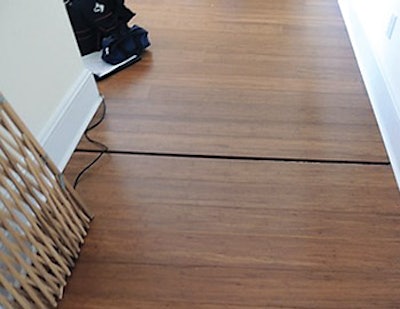

The Problem
A complaint came in that the planks from a floating strandwoven bamboo floor were pulling apart at the seams.
The Procedure
In spring, approximately 2,000 square feet of floating strandwoven bamboo flooring was installed. The material was brought to the house and stored for three days prior to installation, and the cartons were not opened. The customers advised the installer that they did not want transition moldings installed, so they were not used.Initially, both the installer and customers were satisfied with the floor. As winter approached, however, the customers began noticing areas where the planks appeared to be pulling apart from one another at the seams and underneath the moldings. They contacted the retailer and initiated a warranty claim, citing this as a product "defect."
The Cause
A certified inspector on a site inspection found that while the installer may have left adequate perimeter expansion initially, as the floor dried and lost moisture during the heating season, it moved and came in contact with vertical obstructions. With its movement restricted, tension was placed on the joints, and these began to pull apart. The inspector determined the cause to be "inadequate expansion due to the lack of the required transition moldings being installed as per the flooring manufacturer's guidelines" and "improper acclimation." Not surprisingly, the consumer and installer rejected this, and the installer argued that the floor was not touching at the door jambs because these were undercut and that he "let it sit in the home for three days prior to installation."
Strandwoven bamboo tends to acclimate very slowly due to the inherent density of the material. In this instance, the installer failed to properly document the site conditions prior to installation and failed to check the flooring for the appropriate MC. A professional installer should test the material upon delivery to ensure that it does not have elevated moisture levels and should consult with the moisture meter manufacturer to determine the proper settings for the meter. Strandwoven bamboo should be kept consistently in the 6-8% MC range.
How to Fix the Floor
The repair options are to either remove and re-install the existing flooring with the necessary transition moldings (an expensive and time-consuming endeavor), or, in most cases, depending on the severity of the shrinkage, a mechanic can replace a small section, introducing relief cuts to relieve the tension between areas of the installed material, and simply install transition moldings. Mechanics should be careful not to compromise the integrity of the joint. If the floor is removed and reinstalled, it is likely that some material may be damaged, so hopefully the consumer has remaining extra stock.
In the Future
I have never encountered a consumer or installer who wants to use transition moldings. They are often viewed as being unsightly and a tripping hazard, and consumers tend to think they draw attention away from the natural beauty of the floor. However, strandwoven bamboo is extremely sensitive to changes in moisture, temperature and humidity in its surrounding environment. It is imperative that the interior humidity not be allowed to fall below 30%. Drier, arid environments tend to encounter more problems than other more moderate climatic regions. Using transition moldings and humidification controls or in-room humidifiers will minimize the appearance of gaps.
More photos:











